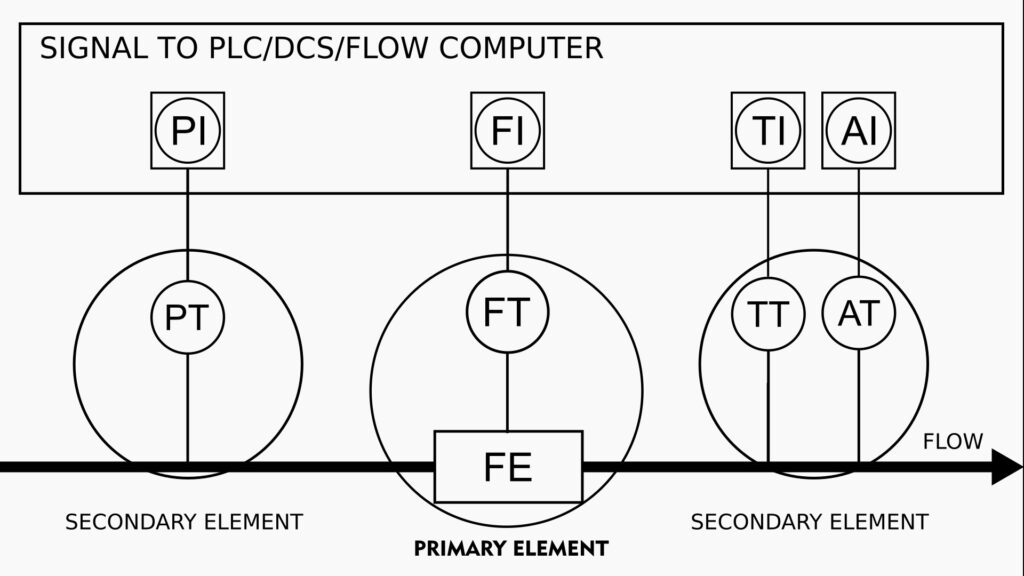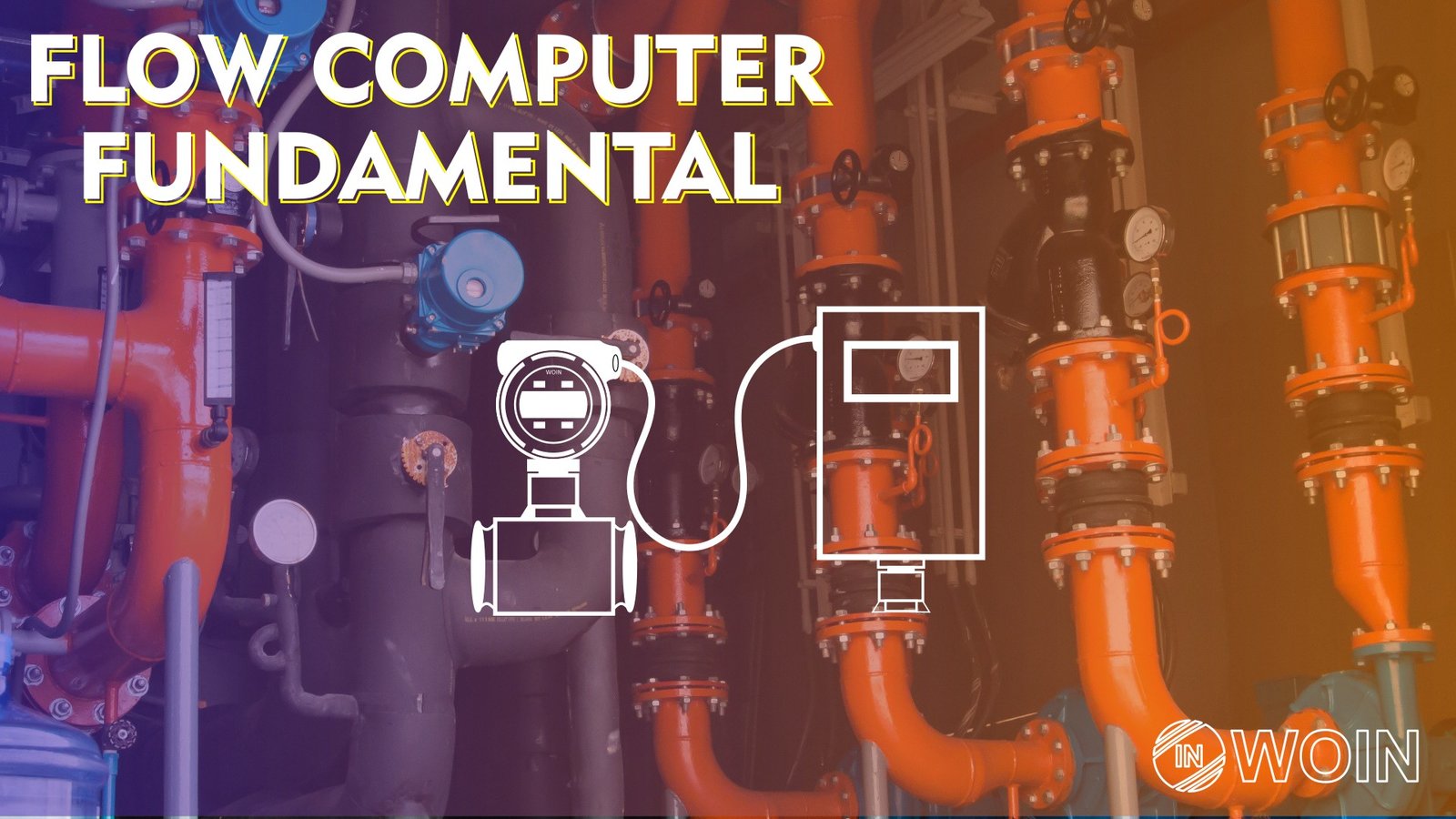Introduction: –
Accurate Flow measurement is a very important and difficult task for process industries. in this post, I will give you How Flow computers Work to measure Accurate Flow.
There are many methods for measuring flow in process industries. Now you think that flow transmitters are given direct data of flow then why do we need separate flow computers for it.
There are many different ways to measure flow in process industries. according to conditions and requirements, a specific type of flow measurement technique is selected.
Accurate flow measurement is a very difficult task in the industry because fluid is changing its characteristics according to certain conditions.
To tackle these problems, we have to also measure environmental conditions like temperature, static pressure, and differential pressure.
Flow Measurement

Different types of flowmeters: –
| Type (Principle used) | Flowmeter |
|---|---|
| Velocity Type | Electromagnetic Turbine Ultrasonic Vortex Type Hotwire |
| Head Type | Orifice Plate Pitot Tube Flow Nozzle Venturi Tube Rotameter |
| Mass Flow Measurement | Coriolis Thermal |
There are many types of flow transmitters available that follow different types of working principles. According to certain conditions, a particular type of flow transmitter is selected in the plant.
I will write briefly about this topic in an upcoming post. and I will also discuss flow transmitter selection criteria.
Overview of flow measurement: –
Industrial flow measurement is a very important topic for discussion, specifically, gas flow measurement is difficult.
In gas flow measurement environmental conditions and physical properties of gas also change and it will affect the accuracy of flow measurement.
American Petroleum Institute sets up standards for electronic gas flow measurement and provides a specification for accurate gas and liquid flow measurement.

Standards for flow measurement by API (American Petroleum Institute)– API MPMS-21.1/.2
American Petroleum Institute introduced API MPMS-21 for a flow measurement using electronic metering systems and divided it into two parts.
- 21.1- Electronic gas measurement
- 21.2- Electronic inferred Mass

This standard API setting and providing guidelines and algorithms for measuring the flow of gas in industrial conditions. Below listed things are included in the standard.
- The electronic Flow measurement system
- Electronic gas flow measurement algorithms
- Audit and Report requirements
- Equipment installation and calibration
- Equipment security
More about this topic I will discuss later. Going through this information I will present to you why we need a separate flow computer for flow measurement.
API MPMS 21.1- Electronic Gas Measurement Standard: –
In electronic gas measurement, there are many variables that need to be measured for accurate flow measurement and API MPMS 21.1 provides minimum specifications for electronic gas measurement used for measuring and recording flow data.
An EGM is included for the measurement of Pressure, Flow, and Temperature and calculates the volume and energy of the gas.

You can see from this picture there are multiple parameters measured and fed data into the flow computer.
After getting the data flow the computer processes the data according to the algorithm set into the computer memory. let’s see which algorithm is used for measuring the flow of Gas.
for accurate flow measurement, there is a need to measure static pressure, in some types of flow transmitters there is inbuilt static pressure measurement is available.
But in some transmitters, static pressure is separately measured in pipelines e.g., turbine type and rotary type.
Flow Measurement Algorithm use in Flow Computer: –
The flow calculation algorithm is used according to which type of flow measurement method is used example: – in the differential pressure type flow measurement method there will be many parameters are influence accurate flow measurement like pressure, temperature, the compressibility of gas, and gas composition. API provides a separate equation for flow measures using the DP type method.
The algorithm is designed specifically for reducing uncertainty in flow measures by adding multiple parameters and coefficients in the flow measurement equations. in this algorithm there are two types of calculation methods is available.
- Volumetric Flow Rate (Qv)
- Mass flow Rate (Qm)
Volumetric Flow measurement: –
In volumetric flow measurement type, the major variable is the Velocity of fluid. After knowing the velocity of the fluid, you will easily calculate Volumetric flow.
As you can see there are many methods available for measuring fluid velocity, in this post, I will discuss only differential pressure type flow measurement.
After introducing secondary elements in streamline now volumetric flow will be found using this equation and it will be helping to reduce uncertainty.
Qv= Pi * (pipe radius) ^2 * Fr * Fpi * Fpr * Krv * ((Pgauge + Patm) * (Tb+ 459.67) * Zb) / Pb * Zf * (Tb+ 459.67))
- Qv = volumetric flow rate at flowing conditions,
- π(Piperadius2) = pipe cross-sectional area,
- Fr = Reynolds number correction,
- Fpi = flow profile correction for inlet piping flow disturbances,
- Fpr = flow profile correction for insertion probe flow disturbances,
- K = meter K factor/unit conversion factor
- Pgauge = flowing gauge pressure,
- Patmos = atmospheric pressure,
- Pb = base pressure,
- Tf = flowing temperature,
- Tb = base temperature,
- Zf = flowing compressibility,
- Zb = base compressibility
Mass Flow measurement: –
As you can know from your education, density is the ratio of mass and volume.
This equation is only for differential pressure flow measurement. Other equations are also designed for other types of flow measurement techniques in API standards.
D = M / V
- D = Density
- M = Mass
- V = Volume
To find the mass flow rate of the fluid you have directly multiply the specific density value with the volume measured by the transmitter.
Qm = Qv * D
- Qm = Mass flow rate
- Qv = Volume flow
- D = Density of fluid
Now after adding compensation of Pressure, Temperature by getting the data from secondary devices and also adding standard compressibility of the fluid for differential pressure flow.
Qm = Qd * root ((Pf * Td * Zd / Pd * Tf * Zf))
- Qm = mass flow rate
- Qd = uncompensated mass flow rate at design reference density
- Pf = flowing pressure (absolute units)
- Pd = design reference pressure (absolute units)
- Tf = flowing temperature (absolute units)
- Td = design reference temperature (absolute units)
- Zf = flowing compressibility
- Zd = design reference compressibility
Working and Use of Flow Computer: –
Mainly flow computers are used in oil and gas industries for accurate flow measurement of different hydrocarbons and natural gas.
Flow computers are mainly designed for accurate flow measurement and by eliminating uncertainty in the measurement cycle and also store the real-time flow data in memory.
The job of a flow computer is to process multiple parameters collected by transmitters and compute actual flow values according to the algorithm provided in API standards.
Flow computers are mostly used by oil and gas companies because in oil and gas most of the fluids are gaseous and from a selling point of view, accurate flow measurement helps to save lots of money for the company.
Top vendors of flow computers: –
| Number | Company |
|---|---|
| 1 | Emerson |
| 2 | Krohne |
| 3 | ABB |
| 4 | Flowmetrics |
| 5 | KEPmeters |
| 6 | ThermoFisher |
| 7 | Omni |
| 8 | Dynamic |
| 9 | Yokogawa |
| 10 | OVAL |
Resources Sharing: –
for learning more about this topic then please check out this whitepaper by Yokogawa on the fundamentals of flow computer: –
And I also recommended going through API MPMS standards 21.1 and 21.2. By searching on google you will find resources on flow measurement standards.
EndNote: –
This is all about flow computers, and how and when they are used in oil and gas applications.
And I also assume that you grab this information properly and maybe you also find some difficult to absorb the algorithm for this I will make a separate post on the flow measurement algorithm and how it is work.
You can also check my latest post on the Latest interview questions related to instrumentation and automation.



[…] Previous Post […]
[…] Article on Flow Computer Standards Page […]